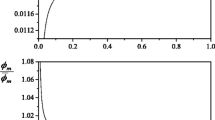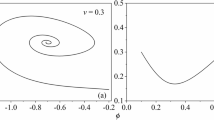Abstract
Present paper studies the contribution of both the quantum effect and the dust size distribution effect on the shock wave characters. It is concluded that the quantum effect of dust particles is negligible, while the quantum effects of both electrons and ions on the shock wave of a quantum dusty plasma cannot be neglected in certain cases. It is found that the speed and the amplitude of the shock wave, considering the dust size distribution, are larger than that of the quantum dusty plasma with the average dust size of a monosized dust plasma. Furthermore, the speed and the amplitude of the shock wave increase, while the width of the shock wave decreases as the ratios of the maximum dust size to the minimum one increases. The quantum effects may affect both the amplitude and width of the shock wave, while it has no effect on the shock wave speed. The width of the shock wave increases, while its amplitude decreases as \(H_e\) and \(H_i\) increase.








Similar content being viewed by others
References
M Horanyi, Annu. Rev. Astron. Astrophys. 34, 383 (1996)
O Havnes, F Melandso, C la Hoz, T K Aslaksen and T Hartquist, Phys. Scr. 45, 535 (1992)
D A Mendis and M Rosenberg, Annu. Rev. Astron. Astrophys. 32, 419 (1994)
S V Vladimirov and K Ostrikov, Phys. Rep. 393, 175 (2004)
N N Rao, P K Shukla and M Y Yu, Planet. Space Sci. 38, 543 (1990)
P K Shukla and V P Silin, Phys. Scr. 45, 508 (1992)
A Barkan, R L Merlino and N DAngelo, Phys. Plasmas 2, 10 (1995)
F Melandso, Phys. Plasmas 3, 3890 (1996)
F Li and O Havnes, Phys. Rev. E 64, 066407 ( 2001)
W Lin, M S Murillo and Y Feng, Phys. Rev. E 100, 4 (2019)
M Marciante and M S Murillo, Phys. Rev. Lett. 118, 2 (2017)
P K Shukla and A A Mamun, Introduction to dusty plasma physics (IOP Publishing Ltd., England, 2002)
V E Fortov, A V Ivlev, S A Khrapak and G E Morfill, Phys. Rep. 421, 1 (2005)
A Brattll, Q Havens and F Melandso, J. Plasma Phys. 58, 691 (1997)
V W Chow, D A Mendis and M J Rosenberg, J. Geophys. Res. 98, 19056 (1993)
M Horanyi and C K Goertz, Astrophys. J. 361, 1 (1990)
W S Duan, Phys. Plasmas 8, 3583 (2001)
P Meuris, F Verheest and G S Lakhina, Planet. Space Sci. 45, 4 (1997)
W S Duan and J Parkes, Phys. Rev. E 68, 067402 (2003)
W S Duan and Y R Shi, Chaos Solitons Fractals 18, 321 (2003)
W S Duan, H J Yang, Y R Shi and K P Lu, Phys. Lett. A 361, 368 (2007)
G Manfredi and F Haas, Phys. Rev. B 64, 075316 (2001)
C Gardner, SIAM Soc. Ind. Appl. Math. J. Appl. Math. 54, 409 (1994)
F Haas, G Manfredi and M Feix, Phys. Rev. E 62, 2763 (2000)
F Haas, L G Garcia, J Goedert and G Manfredi, Phys. Plasmas 10, 3858 (2003)
F Haas, Phys. Plasmas 12, 062117 (2005)
J F Han, D N Gao, H Zhang, X Y Wang and W S Duan, Front. Phys. 10, 105201 (2015)
D Kremp, T Bornath, M Bonitz and M Schlanges, Phys. Rev. E 60, 4725 (1999)
P A Makowich, C A Ringhofer and C Schmeiser, Semiconductor equations (Springer, Vienna, 1990)
Y D Jung, Phys. Plasmas 8, 3842 (2001)
S Ali and P K Shukla, Phys. Plasmas 13, 022313 (2006)
W F El-Taibany and M Wadati, Phys. Plasmas 14, 042302 (2007)
S K El-Labany, N M El-Siragy, W F El-Taibany and E E Behery, Phys. Plasmas 16, 093701 (2009)
J Goswami, S Chandra and B Ghosh, Astrophys. Space Sci. 364, 4 (2019)
J Goswami, S Chandra, J Sarkar, S Chaudhuri and B Ghosh, Breast Cancer Online 38, 1 (2020)
X Qi, Y Xu, W S Duan and L Yang, Phys. Plasmas 21, 1 (2014)
S Sarkar, S Ghosh, M Khan and M R Gupta, Phys. Plasmas 18, 093703 (2011)
H W Yang, Z H Xu, D Z Yang, X R Feng, B S Yin and H H Dong, Adv. Diff. Equ. 2016, 1 (2016)
G Manfredi, Fields Inst. Commun. 46, 263 (2005)
F Haas, L G Garcia, J Goedert and G Manfriedi, Phys. Plasmas 10, 3858 (2003)
P K Shukla and S Ali, Phys. Plasmas 12, 114502 (2005)
S A El-Tantawy, Astrophys. Space Sci. 361, 249 (2016)
H W Yang et al, Adv. Diff. Equ. 2016(1), 1 (2016)
G J He, W S Duan and D X Tian, Phys. Plasmas 15, 043702 (2008)
E F EL-Shamy and A M Al-Asbali, Phys. Plasmas 21, 093701 (2014).
J Zhang, Y Yang, Y X Xu, L Yang, X Qi and W S Duan, Phys. Plasmas 21, 103706 (2014)
E C Whipple, T G Northrop and D A Mendis, J. Geophys. Res. Space Phys. 90, A8 (1985)
U D Angelis, V Formisano and M Giordano, J. Plasma Phys. 40, 3 (1988)
A A Mamun and M N Alam, Indian J. Phys. 72(5), 559 (1998)
N N Rao and P K Shukla, Planet. Space Sci. 42(3), 221 (1994)
T S Gill, H Kaur and N S Saini, J. Plasma Phys. 70(4), 481–495 (2004)
H R Pakzad and K Javidan, Chaos Solitons Fractals 42(5), 2904 (2009)
S V Singh, N N Rao and P K Shukla, J. Plasma Phys. 60(3), 551 (1998)
J K Xue and L P Zhang, Chaos Solitons Fractals 32(2), 592 (2007)
S K El-Labany et al, Phys. Plasmas 16(9), 175 (2009)
N A El-Bedwehy and W M Moslem, Astrophys. Space Sci. 335, 435 (2011)
P Meuris, Planet. Space Sci. 45, 1171 (1997)
H J Ren, Z W Wu, J T Cao and P K Chu, Phys. Plasmas 16, 103705 (2009)
Acknowledgements
This work was supported by the National Natural Science Foundation of China (Grants Nos 11965019 and 11847142).
Author information
Authors and Affiliations
Corresponding authors
Appendices
Appendix A
We have taken the following parameters [27, 32, 33, 58]: \(Z_d=10^{3},\) \(m_d=2\times 10^{-17}\) kg, \(m_e=0.91\times 10^{-30}\) kg, \(m_i=2 \times 10^{-26}\) kg, \(n_d=1.5\times 10^{27}\) m\(^{-3}\), \(n_i=2\times 10^{30}\) m\(^{-3}\), \(\hbar =1.05\times 10^{-34} \)J\(\cdot \)s, \(T_{\mathrm {eff}}=3.1\times 10^{-13}\) J, \(\mu _{i}=1.3\), \(\mu _{e}=0.3\). We have
Hence, the contributions of dust and ion are much lower than the electron.
Appendix B
We have model fluid equations
We introduce the stretched coordinates
and
The asymptotic expansions of the perturbed quantities are given as
Substituting eqs (B.8)–(B.13) into eqs (B.1)–(B.5), and collecting the powers of \(\epsilon ^{3}\), we assume \(\eta =\epsilon \eta '\)
Collecting terms of the same powers of \(\epsilon ^{4}\), the y- and z-components of the second-order perturbed velocity are calculated as
From eq. (B.15) and (B.18)–(B.20), we get
We put \(\sigma _d=0\) leading to a simplified linear dispersion relation
Collecting the powers of \(\epsilon ^{5}\), we have
Solving eqs (B.25)–(B.31) with the aid of eqs (B.14)–(B.24), we get ZK-Burgers equation
where the values of A, B, C and D are consistent with eqs (16)–(19).
Rights and permissions
About this article
Cite this article
Tao, LL., Wei, L., Liu, B. et al. The effect of dust size distribution on shock wave in quantum dusty plasma. Pramana - J Phys 95, 111 (2021). https://doi.org/10.1007/s12043-021-02143-8
Received:
Revised:
Accepted:
Published:
DOI: https://doi.org/10.1007/s12043-021-02143-8




